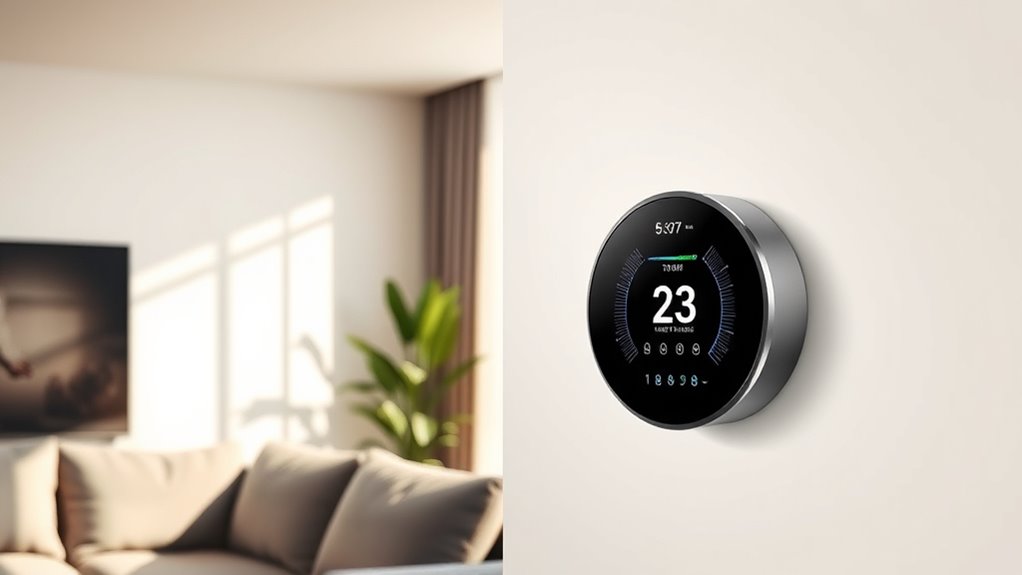If you’re looking for the best smart thermostats of 2025 that learn your habits, I’ve got you covered. Models like the Google Nest Learning Thermostat (3rd and 4th Gen), ecobee Smart Thermostat Essential, and Sensi Lite stand out for their sleek designs, energy savings, and smart features. They adapt to your routines, support voice control, and optimize comfort effortlessly. Keep exploring to discover how these smart thermostats can transform your home environment and save you money.
Key Takeaways
- The latest models feature advanced adaptive learning algorithms that optimize heating and cooling schedules automatically.
- Top smart thermostats integrate seamlessly with popular voice assistants and smart home ecosystems for personalized control.
- Many models offer energy reports and savings insights to help users understand and improve their habits.
- New designs emphasize sleek aesthetics, minimalistic interfaces, and user-friendly setups for enhanced convenience.
- Enhanced sensors and occupancy detection improve comfort and efficiency by learning household routines over time.
Google Nest Learning Thermostat, 3rd Gen
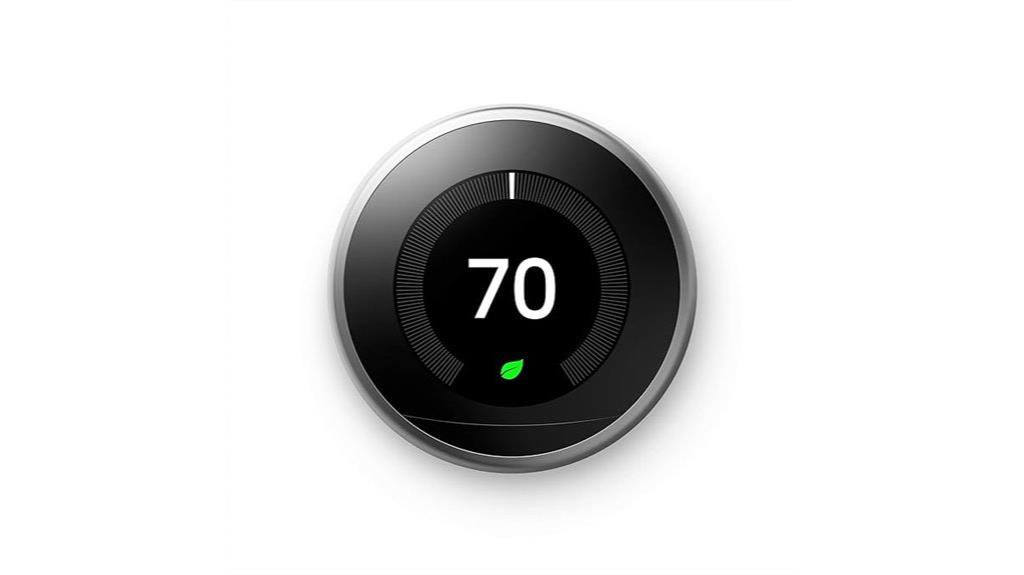
If you’re looking for a smart thermostat that truly adapts to your schedule, the Google Nest Learning Thermostat (3rd Gen) is an excellent choice. Its sleek design and bright, round display make it both functional and stylish. It learns your heating and cooling habits through Auto-Schedule, so you don’t need to program it manually. With remote control via the Nest app, you can adjust settings from anywhere. Compatible with Wi-Fi, Bluetooth, and voice assistants like Alexa and Google Assistant, it offers seamless integration. Plus, it helps save energy—averaging around 10-12% on heating and 15% on cooling—making it a smart investment.
Best For: homeowners seeking a stylish, energy-saving smart thermostat that learns their schedule and integrates seamlessly with voice assistants and remote control.
Pros:
- Learns your schedule automatically, reducing manual programming effort
- Supports remote control and voice commands via Alexa and Google Assistant
- Helps save energy with proven efficiency, leading to cost savings
Cons:
- Requires a C wire for power, which may not be available in all homes
- Installation and setup may take some time, especially for users unfamiliar with wiring
- Firmware updates and reboots might be needed to resolve initial bugs or improve performance
Google Nest Learning Thermostat (4th Gen, 2024) with Nest Temperature Sensor
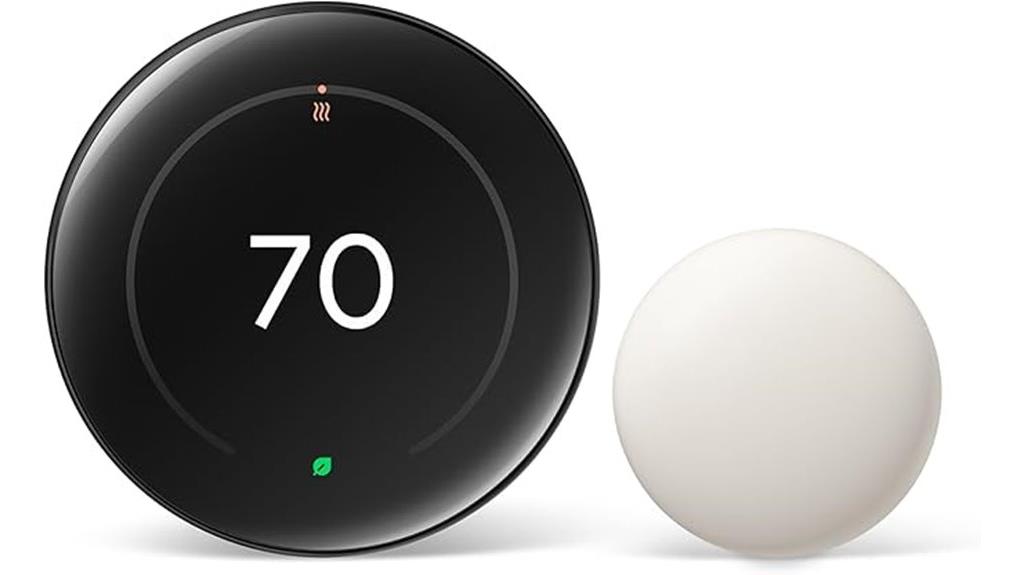
The Google Nest Learning Thermostat (4th Gen, 2024) with Nest Temperature Sensor stands out as an excellent choice for anyone seeking a sleek, intelligent climate control system that adapts to their habits. Its polished obsidian finish, large display with Dynamic Farsight, and minimalistic design make it both stylish and functional. Compatible with most 24V HVAC systems, it’s easy to install, often without a C-wire. The thermostat learns your preferences over time, optimizing comfort and saving energy—averaging 12% on heating and 15% on cooling bills. The included Nest Temperature Sensor allows precise multi-room control, and remote management via app or voice makes it highly convenient.
Best For: homeowners seeking a stylish, energy-efficient smart thermostat that seamlessly integrates with their existing HVAC system and smart home ecosystem.
Pros:
- Sleek, minimalistic design with a larger, adjustable display for easy readability
- Learns user preferences over time to optimize comfort and reduce energy bills
- Compatible with most 24V systems and supports remote control via app and voice commands
Cons:
- Occasional software updates may cause learning or connectivity issues
- Some users report initial setup challenges or limited compatibility with certain HVAC systems, especially outside North America
- Higher price point compared to basic thermostats, which may be a consideration for budget-conscious users
Amazon Smart Thermostat
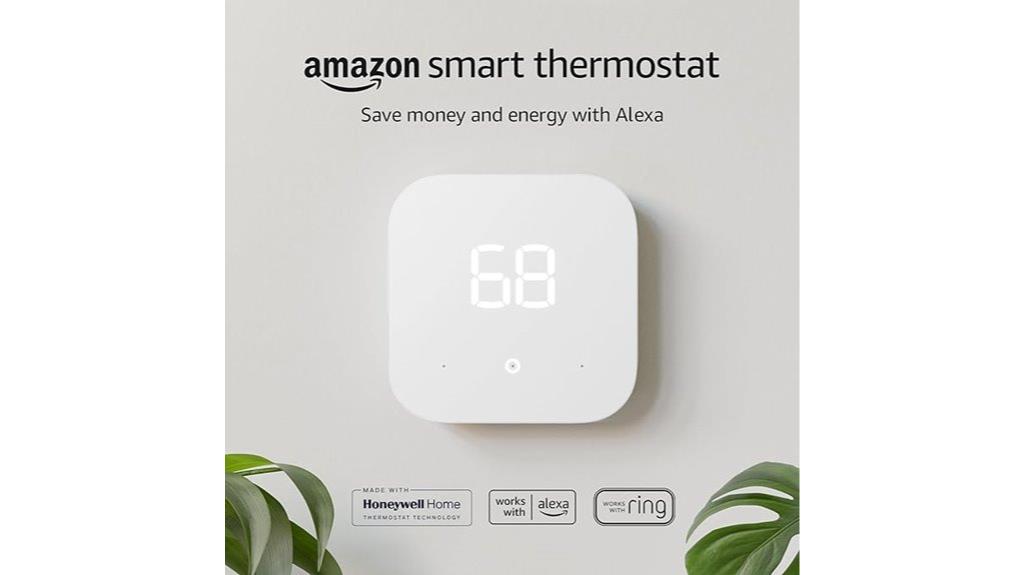
For homeowners seeking an affordable yet reliable smart thermostat, the Amazon Smart Thermostat stands out with its seamless integration with Alexa and support for most 24V HVAC systems. Developed with Honeywell, it offers easy setup via the Alexa app and supports features like scheduling, home and away modes, and voice control. Certified ENERGY STAR, it helps save about $50 annually on energy bills. It works well with sensors to address hot or cold spots and can be controlled remotely. While wiring can be tricky, most users find installation straightforward. Overall, it’s a cost-effective, user-friendly option for upgrading your home’s climate control.
Best For: homeowners looking for an affordable, easy-to-install smart thermostat compatible with most 24V HVAC systems and integrated with Alexa for voice and remote control.
Pros:
- Supports scheduling, home/away modes, and voice control via Alexa.
- Certified ENERGY STAR, helping save approximately $50 annually on energy bills.
- Easy setup through the Alexa app with comprehensive installation tools included.
Cons:
- Wiring installation can be challenging, especially for split units or without a spare C-wire.
- Connectivity issues may occur after power outages, requiring manual resets.
- Not compatible with 110-240V systems, limiting use in some homes.
ecobee Smart Thermostat Essential (2025 Model)

The ecobee Smart Thermostat Essential (2025 Model) stands out for its Energy Star certification and seamless compatibility with popular voice assistants like Siri, Alexa, and Google Assistant, making it an ideal choice for homeowners seeking energy efficiency combined with smart home integration. I appreciate its easy installation, LCD display, and touch controls, along with features like auto-scheduling and auto-away mode. Designed for various HVAC systems, it helps save up to 23% on energy bills, paying for itself quickly. Its compact, wall-mounted design and reliable app control make it user-friendly, while technical support guarantees smooth setup and ongoing use.
Best For: homeowners seeking an energy-efficient, easy-to-install smart thermostat compatible with multiple voice assistants and HVAC systems.
Pros:
- Easy installation with straightforward setup and reliable app control
- Compatible with Siri, Alexa, Google Assistant, and Apple HomeKit for seamless smart home integration
- Energy savings of up to 23% that can offset initial costs within six months
Cons:
- Limited scheduling options, allowing only one schedule per season and 30-minute interval adjustments
- Some users experience mounting challenges due to hole misalignment or wiring issues
- Basic scheduling features and lack of detailed start time adjustments may not suit users with complex routines
Sensi Lite Smart Thermostat
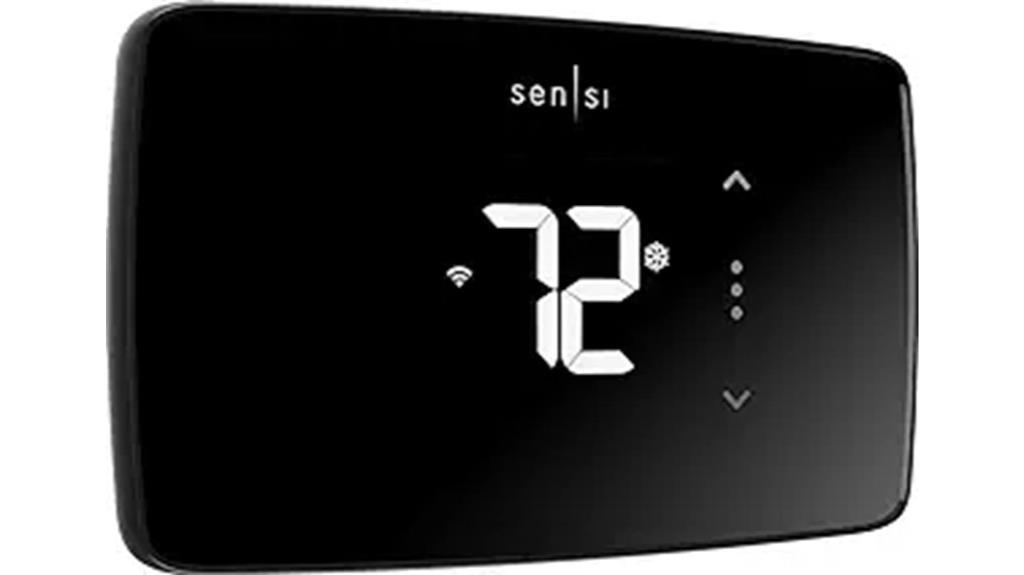
If you’re seeking an easy-to-install smart thermostat that helps cut energy bills without sacrificing convenience, the Sensi Lite Smart Thermostat is an excellent choice. It’s designed for DIY installation, with a built-in level and step-by-step instructions, and works with most HVAC systems. With Wi-Fi, Alexa, Google Assistant, and SmartThings compatibility, it’s flexible and user-friendly. You can control it remotely via a simple app, set schedules, and monitor energy usage. Certified by Energy Star, it can save around 23% on HVAC costs. Its sleek LCD display, backlight, and features like auto changeover and filter indicators make it both practical and energy-efficient.
Best For: DIY homeowners seeking an easy-to-install, energy-efficient smart thermostat compatible with popular smart home platforms.
Pros:
- Easy DIY installation with step-by-step instructions and built-in level
- Compatible with Wi-Fi, Alexa, Google Assistant, and SmartThings for seamless smart home integration
- Energy Star certified, helping save approximately 23% on HVAC costs
Cons:
- Some users experience initial Wi-Fi connectivity issues or difficulty maintaining a stable connection
- Limited temperature adjustment to whole degrees, with no half-degree precision available
- Support lines may have lengthy wait times, and occasional compatibility challenges may arise with certain HVAC systems
Google Nest Thermostat, Programmable Wi-Fi Thermostat
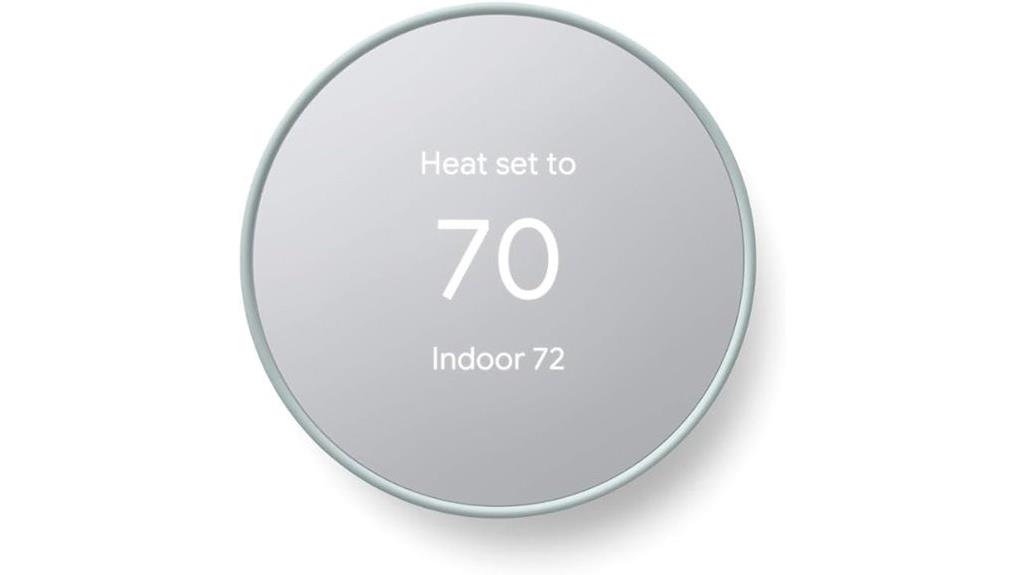
With its sleek circular design and advanced learning capabilities, the Google Nest Thermostat stands out as an excellent choice for homeowners seeking effortless energy management. It’s compatible with most HVAC systems, including heat pumps, and supports voice control via Google Assistant or Alexa. The thermostat can be controlled remotely through the Google Home app, making adjustments easy from anywhere. It automatically creates energy-efficient schedules and detects when you’re away to reduce waste. While installation is straightforward—often under 30 minutes—some regional limitations and wiring requirements may pose challenges. Overall, users appreciate its modern look, energy savings, and seamless smart home integration.
Best For: homeowners seeking an easy-to-use, energy-efficient smart thermostat compatible with a wide range of HVAC systems and integrated with popular voice assistants.
Pros:
- Sleek circular design with modern aesthetics that complement contemporary home decor
- Supports energy-saving scheduling and detects when you’re away to optimize usage
- Compatible with voice control via Google Assistant and Alexa for hands-free adjustments
Cons:
- Regional restrictions and wiring requirements may complicate installation outside the US or with certain HVAC systems
- App interface can be less intuitive, requiring more navigation compared to older models
- Some users experience initial battery issues or compatibility problems with specific wiring configurations
Sensi Smart Thermostat

Choosing the Sensi Smart Thermostat means opting for an energy-efficient, DIY-friendly device that fits most residential HVAC systems without needing a common wire. It’s Energy Star certified, Wi-Fi enabled, and compatible with boilers, heat pumps, and furnaces. Installation is straightforward thanks to its sleek design, LED display, and app guidance, making setup simple even for beginners. It can reduce energy use by around 23%, saving you money on utility bills. Plus, remote control, flexible scheduling, and real-time reports keep you in charge of your comfort and savings. With reliable connectivity and a 3-year warranty, the Sensi thermostat is a smart, affordable choice for modern homes.
Best For: homeowners seeking an easy-to-install, energy-efficient smart thermostat that works with most residential HVAC systems without requiring a common wire.
Pros:
- Simple DIY installation with app guidance and no need for a common wire in most cases
- Energy Star certified, capable of reducing energy consumption by approximately 23%
- Compatible with voice assistants like Alexa, Google Assistant, and SmartThings for hands-free control
Cons:
- May require a C-wire or jumper wires for certain heating-only systems or Wi-Fi stability issues
- Limited advanced programming features compared to higher-end models like Nest or Ecobee
- Some users report occasional Wi-Fi connectivity drops or system rebooting issues
ecobee Smart Thermostat Enhanced – Programmable Wifi Thermostat

The ecobee Smart Thermostat Enhanced stands out for its advanced occupancy detection and energy-saving features, making it ideal for homeowners who want a thermostat that adapts to their daily routines. It automatically adjusts temperatures based on occupancy, offers eco+ settings to reduce energy use during away or sleep modes, and integrates seamlessly with Apple HomeKit, Alexa, Google Assistant, and more. Installation is straightforward with clear app instructions, though wiring can be tricky for some systems. Customers love its remote control, scheduling, and compatibility, but have noted occasional display issues and customer service delays. Overall, it’s a reliable, feature-rich choice for those seeking a smart, energy-efficient thermostat.
Best For: homeowners seeking a smart, energy-efficient thermostat with advanced occupancy detection and seamless smart home integration.
Pros:
- Compatible with popular smart home platforms like Apple HomeKit, Alexa, Google Assistant, and IFTTT
- Features eco+ settings that help reduce energy consumption during away or sleep modes
- Easy installation with clear app instructions and remote control capabilities
Cons:
- Occasional display issues, such as the standby screen turning off when not nearby
- Customer service delays and difficulties in resolving technical or warranty issues
- Wiring can be complex for systems without a C-wire, requiring additional components or support
ecobee Smart Thermostat Premium with Sensors and Air Quality Monitor
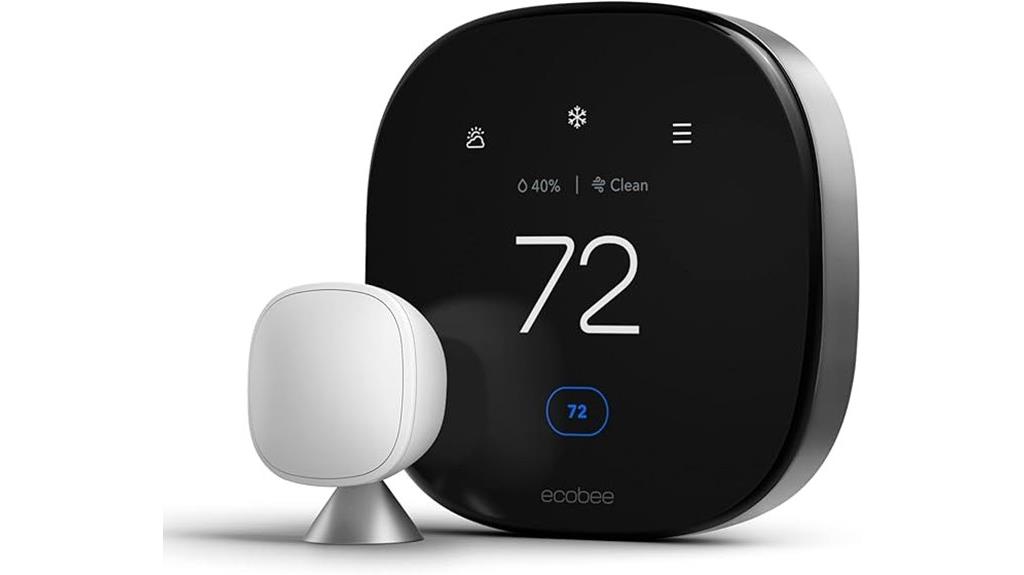
If you’re looking for a smart thermostat that prioritizes energy savings and home comfort, the ecobee Smart Thermostat Premium with Sensors and Air Quality Monitor is an excellent choice. It can save up to 26% annually on heating and cooling costs and is ENERGY STAR certified. The included SmartSensor adjusts temperatures in key rooms, eliminating hot or cold spots. Its built-in air quality monitor alerts you to poor conditions and suggests improvements. Additional features like occupancy sensing, smoke detection, and a security hub make it a versatile upgrade. Compatibility with most HVAC systems and easy app control ensure you stay connected and in control, even remotely.
Best For: homeowners seeking a comprehensive smart thermostat that offers energy savings, air quality monitoring, and home security features, compatible with various HVAC systems.
Pros:
- Up to 26% annual energy savings and ENERGY STAR certification for efficiency
- Includes SmartSensor for improved temperature control in key rooms and elimination of hot/cold spots
- Built-in air quality monitor with alerts and improvement tips, plus security and smoke detection capabilities
Cons:
- Installation can be complex and may require professional assistance, especially for wiring and sensor placement
- Setup instructions for sensors and wiring can be confusing, potentially causing frustration among users with limited technical experience
- The touchscreen may be difficult for visually impaired users, requiring control via app on smartphones or tablets
Google Nest Learning Thermostat (3rd Generation, Renewed)

For those who prioritize energy savings and smart home integration, the Google Nest Learning Thermostat (3rd Generation, Renewed) offers a compelling option. Made of stainless steel with a sleek round LCD display, it supports app and voice control via Google Assistant and Alexa. It learns your habits to optimize temperature settings and reduces energy use, earning Energy Star certification. While installation can be straightforward for simple systems, some users face setup and connectivity challenges. Reviews are mixed, with praise for remote control and energy savings, but issues like temperature inaccuracies and reversion to eco mode are common. Overall, it’s a solid choice for tech-savvy users wanting automation and savings.
Best For: tech-savvy homeowners seeking smart, energy-efficient heating and cooling control with remote access and voice command capabilities.
Pros:
- Learns user habits to optimize temperature settings and enhance energy savings.
- Supports app and voice control via Google Assistant and Alexa for convenient operation.
- Energy Star certified, indicating energy-saving features and environmental friendliness.
Cons:
- Installation and setup can be challenging, especially for complex or older systems.
- Some users report temperature inaccuracies, connectivity issues, and reversion to eco mode.
- Reliability concerns with refurbished units, potential malfunctioning, or missing parts.
Google Nest Thermostat E, Programmable Smart Thermostat

Anyone looking to cut energy costs without sacrificing comfort will find the Google Nest Thermostat E an excellent choice, thanks to its auto-scheduling and learning capabilities. Its sleek, frosted display blends seamlessly into home decor, and it’s easy to control via app, voice, or manual operation. The thermostat learns your preferences over time, adjusting heating and cooling accordingly to save energy. It supports features like Home/Away Assist and works with the Nest Temperature Sensor for room-specific control. With proven savings of up to 15%, it offers an affordable, user-friendly way to optimize your home’s climate while reducing your utility bills.
Best For: homeowners seeking an affordable, user-friendly smart thermostat that offers energy savings and easy control via app, voice, or manual operation.
Pros:
- Learns user preferences over time to optimize heating and cooling schedules
- Supports remote control, voice commands, and integrates with smart home systems like Alexa and Google Assistant
- Provides energy-saving features such as Home/Away Assist and the Nest Leaf indicator
Cons:
- May encounter installation challenges, especially on older systems without a C-wire
- Some users experience issues with temperature accuracy or voice command responsiveness
- Limited compatibility with certain HVAC systems may require professional installation or additional wiring
Honeywell Home Wi-Fi Smart Color Thermostat
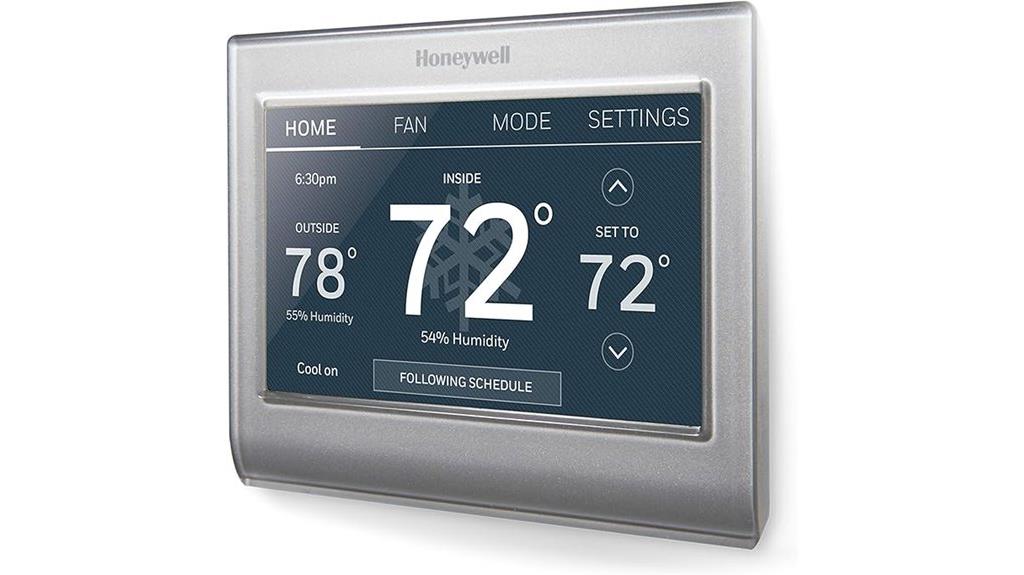
The Honeywell Home Wi-Fi Smart Color Thermostat stands out for its customizable color display, allowing users to match their décor and personalize their space easily. Its intuitive touchscreen makes setup simple, while flexible seven-day programming helps optimize comfort and energy savings. Compatible with various heating systems, it supports voice control through the Total Connect Comfort app and Alexa, enabling remote management. The built-in humidity sensor and auto mode enhance efficiency, adjusting temperatures automatically. Users appreciate its sleek design, clear display, and energy reports, though some find initial installation tricky. Overall, it combines style, smart features, and energy control in a user-friendly package.
Best For: homeowners seeking a customizable, easy-to-use smart thermostat that enhances energy efficiency and integrates seamlessly with voice control options.
Pros:
- Customizable color display to match décor and personalize the space
- Intuitive touchscreen interface with straightforward setup
- Compatible with various heating systems and supports remote control via app and voice commands
Cons:
- Initial installation can be tricky for some users
- Delicate wire connectors may require careful handling during setup
- Full integration with voice assistants may sometimes be limited or require additional setup
Google Nest Learning Thermostat (3rd Gen, Renewed)

The Google Nest Learning Thermostat (3rd Gen, Renewed) stands out for its advanced self-learning features that adapt to your routine, making it ideal for those seeking effortless energy savings and comfort. It connects via Wi-Fi and works with Alexa, offering remote control through an app or voice commands. Its sleek, round design fits seamlessly into modern homes, and setup is straightforward—no C-wire needed. Customers praise its intuitive learning ability and energy efficiency, though some note occasional Wi-Fi connectivity issues over time. Overall, it’s a reliable, stylish option that helps optimize home comfort while saving energy.
Best For: homeowners seeking an easy-to-use, energy-efficient smart thermostat that learns their schedule and integrates seamlessly with Wi-Fi and Alexa.
Pros:
- Self-learning technology adapts to your routines for optimized comfort and energy savings
- Easy installation with no need for a C-wire and straightforward setup via the Nest app
- Sleek, modern design that complements contemporary home decor
Cons:
- Potential Wi-Fi connectivity issues over time, affecting remote control functionality
- Renewed/refurbished status may cause concerns about long-term durability and transparency
- Occasional setup or troubleshooting challenges reported by some users
Google Nest Learning Thermostat, 3rd Gen

If you’re looking for a smart thermostat that seamlessly adapts to your schedule and preferences, the Google Nest Learning Thermostat, 3rd Gen, is an excellent choice. It learns your routines and programs itself to optimize comfort and energy savings. Features like Home/Away Assist automatically set Eco Temperatures when you’re out, and remote control lets you adjust settings from anywhere. The high-res display with Farsight technology shows weather, time, or temperature instantly. Easy to install and compatible with most systems, it integrates well with the Google Nest ecosystem. Customers praise its user-friendly design, reliable performance, and energy-saving capabilities, making it a top pick in home automation.
Best For: homeowners seeking an easy-to-use, energy-efficient smart thermostat that adapts to their schedule and integrates seamlessly with smart home systems.
Pros:
- Learns your routines to optimize comfort and energy savings automatically
- Easy installation compatible with most heating and cooling systems
- High-resolution display with Farsight technology for quick access to information
Cons:
- May require additional sensors for room-specific temperature control
- Some users experience early device failure or technical issues
- Limited customization options compared to more advanced smart thermostats
Nest Thermostat E Smart Thermostat (T4002ES)
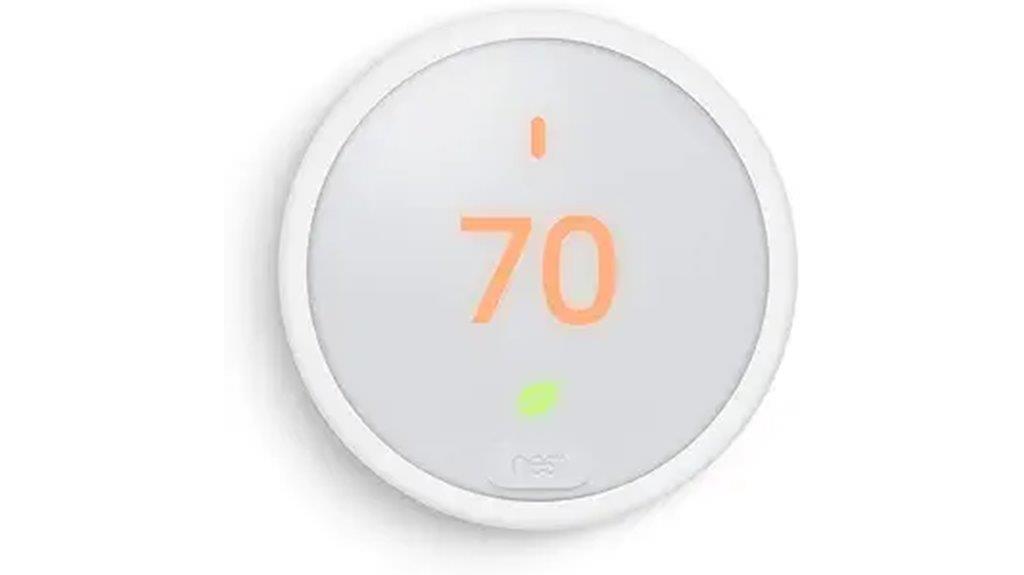
Designed for homeowners seeking an affordable yet smart way to optimize comfort and energy savings, the Nest Thermostat E stands out with its sleek, minimalist design and user-friendly features. It works with most 24V heating and cooling systems, supports app control, and is compatible with voice assistants like Alexa and Google Assistant. Its simple spin dial makes manual adjustments easy, especially on light-colored walls. The thermostat learns household routines over time, optimizing energy use and offering eco modes when you’re away. Installation is quick, typically within an hour, but some users report connectivity or power setup issues. Overall, it’s a cost-effective choice for smart, flexible home climate control.
Best For: homeowners seeking an affordable, easy-to-install smart thermostat compatible with most 24V heating and cooling systems who want remote control, energy savings, and simple manual adjustments.
Pros:
- Supports app control via Wi-Fi and voice assistants like Alexa and Google Assistant for convenient remote management.
- Easy to install within approximately 60 minutes, suitable for most 24V systems with or without C-wire.
- Learns household routines over time to optimize energy use and offers eco modes to save on energy costs.
Cons:
- Small display and unclear visuals can make temperature readings and programming less user-friendly.
- Some users experience connectivity, power, or charging issues requiring troubleshooting or additional components.
- Installation may require additional wiring or transformers, especially for older or 2-wire systems, which can complicate setup.
Factors to Consider When Choosing Smart Thermostats Learning

When choosing a smart thermostat that learns your habits, I consider how well it works with my existing system and how deep its learning capabilities are. I also look at how easy it is to install, along with features like energy savings, app control, and voice commands. These factors help me find a device that’s both effective and simple to use.
Compatibility With Systems
Choosing a smart thermostat that truly works with your home’s HVAC system requires careful attention to compatibility. First, confirm the device supports your system’s voltage and wiring, whether it’s 24V, 110V, or 240V. Check if your wiring includes a C-wire, or if the thermostat can operate without one. It’s also essential to verify that the thermostat is compatible with your specific heating and cooling equipment, like heat pumps or electric baseboards. Additionally, consider how well it integrates with your smart home ecosystem—Google Home, Alexa, or Apple HomeKit—for seamless control. In conclusion, review the manufacturer’s compatibility list or online tools to confirm it matches your system type and regional electrical standards. This ensures smooth installation and reliable operation.
Learning Capabilities Depth
The depth of a smart thermostat’s learning capabilities considerably impacts how well it adapts to your household routines. Some devices learn quickly, adjusting within days, while others may take weeks to optimize their settings. Advanced models can differentiate between routines, like workdays versus weekends, and tailor temperature adjustments accordingly. The sophistication of their algorithms often depends on additional sensors or data inputs, which improve their understanding of occupancy and comfort preferences. Furthermore, machine learning techniques enable these thermostats to refine their schedules over time, increasing energy savings and comfort. User interaction also plays a role; frequent manual adjustments can either speed up or hinder the system’s ability to develop accurate, autonomous schedules. Overall, deeper learning capabilities translate into smarter, more efficient climate control.
Installation Complexity Level
Understanding how easily a smart thermostat can be installed is key to making the most of its learning features. If your system has a C-wire, installation tends to be straightforward, especially for DIY enthusiasts, since most models include clear setup guides. Without a C-wire, you’ll likely need additional components like power extender kits or transformers, which can complicate installation. Compatibility with older or complex HVAC systems can also increase setup time and might require professional help. Many user-friendly thermostats come with step-by-step instructions via apps, simplifying the process. However, if your system has multiple wiring options or is a dual or multi-stage setup, it can add to the complexity, making professional installation a wise choice. Overall, understanding your system’s wiring and compatibility is essential.
Energy Saving Features
Energy-saving features are essential considerations when selecting a smart thermostat, as they directly impact your home’s efficiency and your utility bills. I look for models with auto-scheduling, which learns my routines and adjusts temperatures accordingly, saving energy without sacrificing comfort. Home/Away Assist or Eco modes are also valuable, as they automatically reduce heating or cooling when no one’s home or during sleep. Advanced thermostats use occupancy sensors and remote temperature sensors to optimize zones and prevent energy waste. I appreciate devices that provide energy reports and savings estimates—these help me identify better habits. Features like adaptive learning algorithms and real-time adjustments substantially lower energy costs and lessen environmental impact, making these smart thermostats both eco-friendly and cost-effective choices.
App and Voice Control
Controlling a smart thermostat through apps and voice commands adds a layer of convenience that makes managing home climate effortless. With remote control via smartphones, tablets, or smart speakers, I can adjust settings anytime, anywhere. Compatibility with voice assistants like Alexa, Google Assistant, or Siri means I can change the temperature hands-free, seamlessly integrating the thermostat into my smart home. Precise control features, such as adjusting in 0.5-degree increments or setting detailed schedules through the app, help me optimize energy use and comfort. Many models also send real-time notifications about system status, energy consumption, or potential issues, keeping me informed. Overall, seamless app and voice control simplify managing my home’s climate, making it more intuitive and accessible.
Design and Aesthetics
When choosing a smart thermostat, the design and aesthetics are just as important as its features, because it should seamlessly blend into my home decor. I look for sleek, modern shapes like rounded edges and minimalist displays that don’t clutter the space. Customizable color schemes and adjustable brightness let me match the thermostat to my interior style, whether it’s contemporary or traditional. A larger, high-resolution display makes reading easy from across the room, which is a big plus. Materials like stainless steel or polished finishes give a premium feel and look, elevating the overall vibe. Simple, intuitive controls and themes help personalize the device without overwhelming the senses. Ultimately, a well-designed thermostat enhances my home’s aesthetics while remaining highly functional.
Price and Value
Choosing a smart thermostat involves balancing cost with the features and benefits it offers. Prices range from around $50 for basic models to over $250 for premium options, which can impact overall value. Higher-priced thermostats often include advanced features like multiple sensors, detailed energy reports, and seamless compatibility with smart home systems, leading to potential long-term savings. The best value usually comes from models that strike a balance between affordability and energy efficiency, often paying for themselves through lower utility bills within a year. It’s also important to contemplate durability, warranty, and ongoing software support, as these factors influence the thermostat’s lifespan and user experience. Ultimately, matching features to your needs helps ensure you get a smart thermostat that delivers great price-to-value ratio.
Frequently Asked Questions
How Do Smart Thermostats Impact Long-Term Energy Savings?
Smart thermostats really boost long-term energy savings by learning my habits and adjusting the temperature accordingly. I notice my energy bills drop because these devices optimize heating and cooling when I need it most, avoiding waste. They also give me detailed usage data, so I can tweak settings for even better savings. Overall, they make my home more efficient, saving money while keeping me comfortable.
Are Smart Thermostats Compatible With All HVAC Systems?
Smart thermostats aren’t compatible with all HVAC systems. I’ve found that most modern systems work well, especially those with C-wire connections, but older units might need additional wiring or adapters. Before buying, I recommend checking your system’s compatibility and consulting the manufacturer’s guidelines. It’s worth investing a little time to guarantee seamless integration, so you can enjoy the energy savings and convenience these smart devices offer.
What Privacy Concerns Exist With Learning Thermostats?
When I think about privacy concerns with learning thermostats, I realize they collect a lot of personal data, like your daily routines and occupancy patterns. This info is stored online, which raises risks of hacking or unauthorized access. I always recommend checking the privacy policies and security features of these devices. Being cautious helps protect your personal information while still enjoying the convenience of smart home technology.
Can Smart Thermostats Be Controlled Remotely Without Internet?
Controlling a smart thermostat remotely without internet is possible if it has local control options like a physical interface or a direct connection via a hub or Bluetooth. I’ve done this with certain models that support local access, which means I don’t need internet to adjust my settings. However, most smart thermostats rely on Wi-Fi for remote control, so without internet, your options might be limited unless they offer local connectivity features.
How Do Smart Thermostats Adapt to Changing Seasonal Schedules?
When it comes to changing seasons, smart thermostats really have their work cut out for them. They learn from your habits and adapt automatically, adjusting settings as the weather shifts. Many use sensors and algorithms to detect temperature changes and modify heating or cooling schedules. Think of it as having a personal climate control expert who’s always one step ahead, ensuring comfort without you lifting a finger.
Conclusion
Choosing the right smart thermostat is like finding the perfect dance partner—one that moves with your habits, anticipates your steps, and makes every move seamless. When you pick a device that learns your rhythm, your home becomes a harmonious space. Trust your instincts, consider the features, and let your choice lead you into a future where comfort and efficiency move in perfect sync. Your ideal thermostat awaits—ready to dance to your tune.
